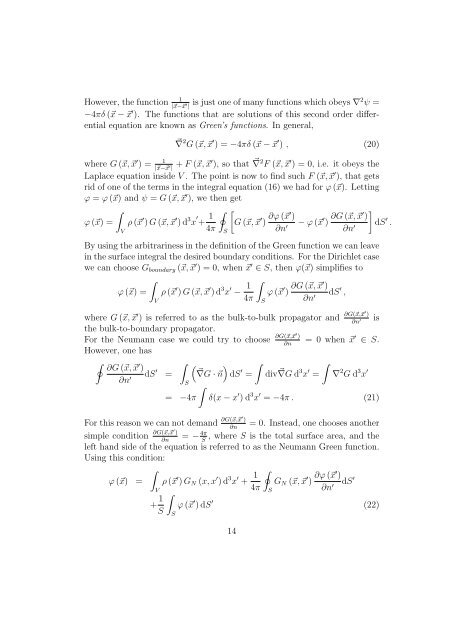Topics in Classical Electrodynamics
Topics in Classical Electrodynamics
Topics in Classical Electrodynamics
Create successful ePaper yourself
Turn your PDF publications into a flip-book with our unique Google optimized e-Paper software.
However, the function<br />
1<br />
|⃗x−⃗x ′ | is just one of many functions which obeys ∇2 ψ =<br />
−4πδ (⃗x − ⃗x ′ ). The functions that are solutions of this second order differential<br />
equation are known as Green’s functions. In general,<br />
⃗∇ 2 G (⃗x, ⃗x ′ ) = −4πδ (⃗x − ⃗x ′ ) , (20)<br />
where G (⃗x, ⃗x ′ ) = 1 + F (⃗x, |⃗x−⃗x ′ | ⃗x′ ), so that ∇ ⃗ 2 F (⃗x, ⃗x ′ ) = 0, i.e. it obeys the<br />
Laplace equation <strong>in</strong>side V . The po<strong>in</strong>t is now to f<strong>in</strong>d such F (⃗x, ⃗x ′ ), that gets<br />
rid of one of the terms <strong>in</strong> the <strong>in</strong>tegral equation (16) we had for ϕ (⃗x). Lett<strong>in</strong>g<br />
ϕ = ϕ (⃗x) and ψ = G (⃗x, ⃗x ′ ), we then get<br />
∫<br />
ϕ (⃗x) =<br />
V<br />
ρ (⃗x ′ ) G (⃗x, ⃗x ′ ) d 3 x ′ + 1<br />
4π<br />
∮<br />
S<br />
[<br />
G (⃗x, ⃗x ′ ) ∂ϕ (⃗x′ )<br />
− ϕ (⃗x ′ ) ∂G (⃗x, ]<br />
⃗x′ )<br />
dS ′ .<br />
∂n ′ ∂n ′<br />
By us<strong>in</strong>g the arbitrar<strong>in</strong>ess <strong>in</strong> the def<strong>in</strong>ition of the Green function we can leave<br />
<strong>in</strong> the surface <strong>in</strong>tegral the desired boundary conditions. For the Dirichlet case<br />
we can choose G boundary (⃗x, ⃗x ′ ) = 0, when ⃗x ′ ∈ S, then ϕ(⃗x) simplifies to<br />
∫<br />
ϕ (⃗x) =<br />
V<br />
ρ (⃗x ′ ) G (⃗x, ⃗x ′ ) d 3 x ′ − 1<br />
4π<br />
∫<br />
S<br />
ϕ (⃗x ′ ) ∂G (⃗x, ⃗x′ )<br />
∂n ′ dS ′ ,<br />
where G (⃗x, ⃗x ′ ) is referred to as the bulk-to-bulk propagator and ∂G(⃗x,⃗x′ )<br />
is<br />
∂n ′<br />
the bulk-to-boundary propagator.<br />
For the Neumann case we could try to choose ∂G(⃗x,⃗x′ )<br />
= 0 when ⃗x ′ ∈ S.<br />
∂n<br />
However, one has<br />
∮ ∂G (⃗x, ⃗x ′ ∫<br />
)<br />
( ) ∫<br />
∫<br />
dS ′ = ⃗∇G · ⃗n dS ′ = div∇G ∂n ⃗ d 3 x ′ = ∇ 2 G d 3 x ′<br />
′ S<br />
∫<br />
= −4π δ(x − x ′ ) d 3 x ′ = −4π . (21)<br />
For this reason we can not demand ∂G(⃗x,⃗x′ )<br />
= 0. Instead, one chooses another<br />
∂n<br />
simple condition ∂G(⃗x,⃗x′ )<br />
= − 4π , where S is the total surface area, and the<br />
∂n<br />
S<br />
left hand side of the equation is referred to as the Neumann Green function.<br />
Us<strong>in</strong>g this condition:<br />
∫<br />
ϕ (⃗x) = ρ (⃗x ′ ) G N (x, x ′ ) d 3 x ′ + 1 ∮<br />
G N (⃗x, ⃗x ′ ) ∂ϕ (⃗x′ )<br />
dS ′<br />
V<br />
4π S<br />
∂n ′<br />
+ 1 ∫<br />
ϕ (⃗x ′ ) dS ′ (22)<br />
S<br />
S<br />
14
















